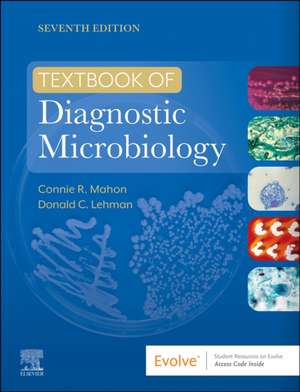Textbook of Diagnostic Microbiology
Autor Connie R. Mahon, Donald C. Lehmanen Limba Engleză Hardback – 17 ian 2023
Gain the knowledge and skills you need to succeed in the clinical lab! Textbook of Diagnostic Microbiology, 7th Edition uses a reader-friendly "building-block" approach to help you learn the essentials of diagnostic microbiology. Featuring full-color drawings and photos, this text helps you learn to develop the critical thinking and problem-solving skills necessary to the accurate diagnosis of infectious diseases and the identification of infectious agents. Written by noted educators Connie R. Mahon and Donald C. Lehman, this edition adds new content on SARS-CoV-2 and COVID-19, along with the latest information on prevention, treatment modalities, and CDC guidelines.
Preț: 648.47 lei
Preț vechi: 915.15 lei
-29% Nou
Puncte Express: 973
Preț estimativ în valută:
124.10€ • 128.83$ • 103.48£
124.10€ • 128.83$ • 103.48£
Carte disponibilă
Livrare economică 24 februarie-10 martie
Preluare comenzi: 021 569.72.76
Specificații
ISBN-13: 9780323829977
ISBN-10: 032382997X
Pagini: 1120
Ilustrații: 970 illustrations (970 in full color)
Dimensiuni: 216 x 276 mm
Greutate: 2.68 kg
Ediția:7
Editura: Elsevier
ISBN-10: 032382997X
Pagini: 1120
Ilustrații: 970 illustrations (970 in full color)
Dimensiuni: 216 x 276 mm
Greutate: 2.68 kg
Ediția:7
Editura: Elsevier
Cuprins
Part 1: Introduction to Clinical Microbiology Chapter 1: Bacterial Cell Structure, Physiology, Metabolism, and Genetics Chapter 2: Host-Parasite Interaction Chapter 3: The Laboratory Role in Infection Control Chapter 4: Control of Microorganisms: Disinfection, Sterilization, and Microbiology Safety Chapter 5: Performance Improvement in the Microbiology Laboratory Chapter 6: Specimen Collection and Processing Chapter 7: Microscopic Examination of Materials from Infected Sites Chapter 8: Use of Colony Morphology for the Presumptive Identification of Microorganisms Chapter 9: Biochemical Identification of Gram-Negative Bacteria Chapter 10: Immunodiagnosis of Infectious Diseases Chapter 11: Applications of Molecular Diagnostics Chapter 12: Antibacterial Mechanisms of Action and Bacterial Resistance Mechanisms Chapter 13: Antimicrobial Susceptibility Testing Part 2: Laboratory Identification of Significant Isolates Chapter 14: Staphylococci Chapter 15: Streptococcus, Enterococcus, and Other Catalase-Negative, Gram-Positive Cocci Chapter 16: Aerobic Gram-Positive Bacilli Chapter 17: Neisseria Species and Moraxella catarrhalis Chapter 18: Haemophilus, HACEK, Legionella and Other Fastidious Gram-Negative Bacilli Chapter 19: Enterobacteriaceae Chapter 20: Vibrio, Aeromonas, and Campylobacter Species Chapter 21: Nonfermenting and Miscellaneous Gram-Negative Bacilli Chapter 22: Anaerobes of Clinical Importance Chapter 23: The Spirochetes Chapter 24: Chlamydia, Rickettsia, and Similar Organisms Chapter 25: Mycoplasma and Ureaplasma Chapter 26: Mycobacterium tuberculosis and Nontuberculous Mycobacteria Chapter 27: Medically Significant Fungi Chapter 28: Diagnostic Parasitology Chapter 29: Clinical Virology Chapter 30: Agents of Bioterror and Forensic Microbiology Chapter 31: Biofilms: Architects of Disease Part 3: Laboratory Diagnosis of Infectious Diseases: and Organ System Approach to Diagnostic Microbiology Chapter 32: Upper and Lower Respiratory Tract Infections Chapter 33: Skin and Soft Tissue Infections Chapter 34: Gastrointestinal Infections and Food Poisoning Chapter 35: Infections of the Central Nervous System Chapter 36: Bacteremia and Sepsis Chapter 37: Urinary Tract Infections Chapter 38: Genital Infections and Sexually Transmitted Infections Chapter 39: Infections in Special Populations Chapter 40: Zoonotic Diseases Chapter 41: Ocular Infections Appendix A: Selected Bacteriologic Culture Media Appendix B: Selected Mycology Media, Fluids, and Stains Appendix C: Selected Procedures Appendix D: Answers to Learning Assessment Questions Glossary


